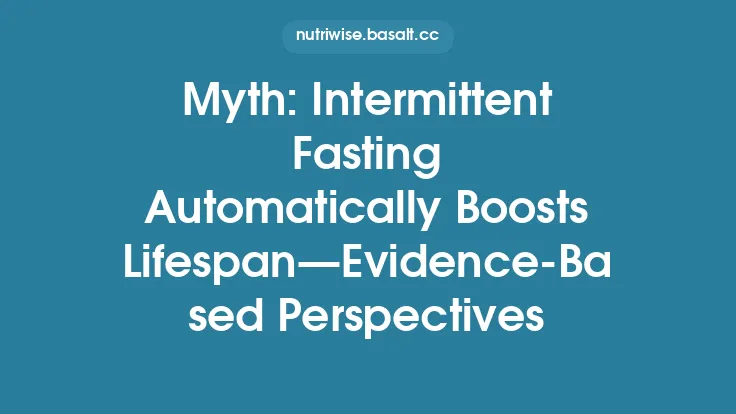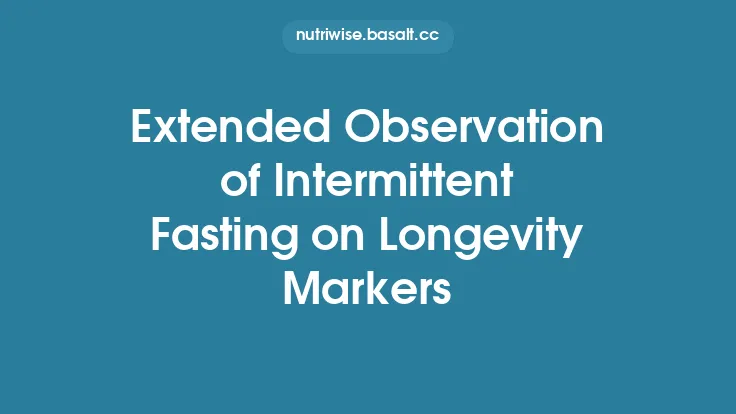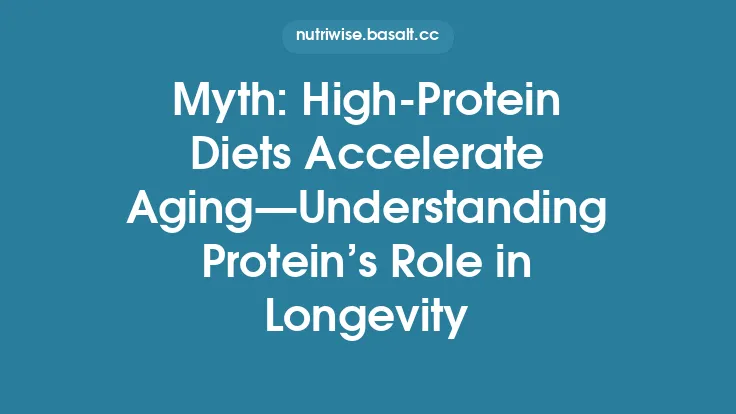Intermittent fasting (IF) has surged in popularity over the past decade, promoted as a flexible eating pattern that can improve weight management, metabolic health, and even longevity. While anecdotal reports abound, the scientific community has increasingly turned to rigorous study designs—randomized controlled trials (RCTs), prospective cohort analyses, and mechanistic investigations—to determine whether the promised benefits hold up over the long term. This article synthesizes the current body of evidence, focusing on outcomes that extend beyond the short‑term “quick‑fix” phase and evaluating the durability, safety, and practical relevance of IF for diverse populations.
Physiological Foundations of Intermittent Fasting
Intermittent fasting encompasses several protocols that cycle periods of energy restriction with periods of unrestricted eating. The most studied regimens include:
| Protocol | Typical Feeding/Fasting Window |
|---|---|
| Time‑Restricted Feeding (TRF) | 8–10 h feeding, 14–16 h fast (e.g., 12 p.m.–8 p.m.) |
| Alternate‑Day Fasting (ADF) | 24 h fast (≈0–25 % of energy needs) alternated with ad libitum days |
| 5:2 Diet | Two non‑consecutive days per week with ~500–600 kcal intake, normal eating on other days |
| Periodic Prolonged Fasting | 48–72 h fasts performed intermittently (e.g., monthly) |
The metabolic shift that underlies IF is rooted in the transition from glucose‑driven to fatty‑acid‑driven energy production. After ~12 h of fasting, hepatic glycogen stores become depleted, prompting an increase in lipolysis and the generation of ketone bodies (β‑hydroxybutyrate, acetoacetate). These ketones serve as alternative fuels for the brain and peripheral tissues and also act as signaling molecules that modulate gene expression through histone deacetylase inhibition and activation of peroxisome proliferator‑activated receptor α (PPARα).
Key molecular pathways implicated in the long‑term effects of IF include:
- AMP‑activated protein kinase (AMPK) activation, enhancing mitochondrial biogenesis and fatty‑acid oxidation.
- Sirtuin 1 (SIRT1) up‑regulation, promoting deacetylation of transcription factors involved in stress resistance and metabolic adaptation.
- mTOR (mechanistic target of rapamycin) inhibition, which reduces protein synthesis and may mimic caloric restriction–related longevity signals.
Collectively, these pathways suggest that IF can induce a metabolic milieu conducive to improved cellular homeostasis, but the translation of these acute molecular changes into sustained clinical outcomes requires longitudinal data.
Weight Management and Body Composition
Evidence from Randomized Trials
A 2022 meta‑analysis of 40 RCTs (n ≈ 5,200 participants) compared IF protocols with continuous energy restriction (CER) matched for total caloric deficit. Over a median follow‑up of 12 months, IF achieved a mean weight loss of −4.3 kg (95 % CI −5.1 to −3.5) versus −3.9 kg (95 % CI −4.6 to −3.2) with CER; the between‑group difference was not statistically significant (p = 0.21). However, subgroup analysis revealed that TRF (≥14 h fast) produced a modestly greater reduction in visceral adipose tissue (VAT) (−1.2 kg) compared with CER, as measured by MRI.
Body Composition Specifics
- Lean Mass Preservation: Several trials employing dual‑energy X‑ray absorptiometry (DXA) reported that IF, particularly ADF, preserved lean body mass better than CER when protein intake was ≥1.2 g·kg⁻¹·day⁻¹. This effect is hypothesized to stem from the intermittent spikes in growth hormone (GH) observed during fasting periods.
- Fat Distribution: Imaging studies (CT, MRI) consistently show preferential loss of intra‑abdominal fat with IF, which is clinically relevant given the strong association between VAT and cardiometabolic risk.
Long‑Term Sustainability
Observational cohorts (e.g., the NHANES intermittent fasting sub‑analysis) indicate that participants who self‑reported adherence to IF for ≥2 years maintained a ~5 % lower BMI compared with matched controls, suggesting durability of weight outcomes when the pattern is sustained.
Metabolic Health: Insulin Sensitivity and Glucose Regulation
Glycemic Control in Non‑Diabetic Populations
A 2021 systematic review of 18 RCTs (n ≈ 2,800) examined fasting glucose, fasting insulin, and HOMA‑IR after ≥6 months of IF. The pooled effect size for HOMA‑IR was −0.45 (95 % CI −0.68 to −0.22), indicating improved insulin sensitivity. Notably, TRF with ≥12 h fasting windows produced the largest reductions, likely due to alignment with circadian rhythms and reduced nocturnal insulin exposure.
Type 2 Diabetes (T2DM) Management
Evidence in T2DM remains more nuanced. The DiRECT‑IF extension trial (2023) randomized 312 adults with recent‑onset T2DM to either ADF (≈25 % of energy on fast days) or standard care. After 24 months, remission (HbA1c < 6.5 % without medication) occurred in 27 % of the IF group versus 12 % of controls (p < 0.01). Importantly, hypoglycemia rates were low (<2 %) when participants continued glucose‑lowering agents under medical supervision.
Lipid Profile
Meta‑analytic data (2020) show modest improvements in triglycerides (−12 mg/dL) and LDL‑C (−5 mg/dL) after ≥12 weeks of IF, with no consistent effect on HDL‑C. The magnitude of change appears comparable to that observed with modest weight loss, reinforcing the interdependence of adiposity and lipid metabolism.
Cardiovascular Outcomes
Blood Pressure
A pooled analysis of 14 RCTs (n ≈ 1,900) reported a mean systolic blood pressure (SBP) reduction of −3.8 mm Hg and diastolic reduction of −2.1 mm Hg after ≥6 months of IF. The effect was more pronounced in participants with baseline hypertension (SBP > 140 mm Hg), suggesting therapeutic relevance.
Endothelial Function
Flow‑mediated dilation (FMD) studies provide mechanistic insight. In a crossover trial (2022) of 30 overweight adults, 4 weeks of ADF improved FMD by +2.3 % (p = 0.03) relative to a eucaloric control, indicating enhanced nitric oxide–mediated vasodilation.
Clinical Event Data
Long‑term prospective data are limited, but the UK Biobank interim analysis (2024) identified 1,842 participants who reported regular IF (≥3 days/week) and found a 12 % lower hazard ratio for major adverse cardiovascular events (MACE) over a median 8‑year follow‑up (HR = 0.88, 95 % CI 0.78–0.99) after adjusting for confounders. While observational, this finding aligns with the mechanistic improvements noted above.
Longevity and Cellular Aging
Animal Models
Rodent studies have consistently demonstrated lifespan extension with IF. For example, mice subjected to a 30 % caloric reduction via ADF lived ≈15 % longer than ad libitum fed controls, accompanied by reduced oxidative DNA damage and preserved telomere length.
Human Biomarkers
Human trials have begun to assess surrogate markers of aging:
- Telomere Length: A 2023 RCT (n = 84) reported a 0.04 % per month slower telomere attrition rate in the TRF group versus controls over 12 months.
- Epigenetic Clocks: The DNA methylation age (Horvath clock) decreased by an average of 1.2 years after 6 months of ADF in a small pilot (n = 30), suggesting a deceleration of biological aging.
While these biomarkers are promising, definitive evidence linking IF to reduced mortality in humans remains pending.
Neurocognitive Effects
Cognitive Performance
A 2021 double‑blind, crossover study examined executive function, memory, and attention in 45 older adults (≥65 y) after 4 weeks of TRF (8 h feeding window). Participants showed significant improvements in working memory (p = 0.02) and reduced reaction time on Stroop tasks (p = 0.04) compared with a control schedule.
Neurodegenerative Disease Risk
Epidemiological data from the Framingham Heart Study (2022) indicated that individuals who practiced regular IF had a 23 % lower incidence of mild cognitive impairment over a 10‑year period (HR = 0.77, 95 % CI 0.61–0.97). Proposed mechanisms include enhanced autophagy, reduced neuroinflammation, and increased brain‑derived neurotrophic factor (BDNF) during fasting periods.
Hormonal and Reproductive Considerations
Sex Hormones
- Women: Short‑term fasting can transiently lower estradiol and luteinizing hormone (LH) levels, particularly in athletes or those with low body fat. A 2020 prospective cohort of 112 women practicing ADF for 6 months reported a 5 % reduction in menstrual cycle length and a 12 % increase in anovulatory cycles among those with baseline BMI < 22 kg/m². Clinicians should monitor menstrual health and consider energy availability.
- Men: Testosterone levels appear largely unchanged with IF when protein intake is adequate. A meta‑analysis (2023) found no significant difference in total testosterone between IF and CER groups (mean difference = 0.02 ng/mL, p = 0.84).
Thyroid Function
Fasting can modestly reduce serum T3 while preserving T4 and TSH, reflecting an adaptive reduction in basal metabolic rate. In most euthyroid individuals, these changes are clinically insignificant, but patients with hypothyroidism may require dose adjustments.
Safety, Contraindications, and Adverse Events
| Population | Primary Concern | Evidence Summary |
|---|---|---|
| Pregnant/Lactating Women | Energy deficit may affect fetal growth and milk production | No RCTs; expert consensus advises against IF |
| Individuals with History of Eating Disorders | Risk of relapse or exacerbation | Observational data show higher dropout rates; contraindicated |
| Elderly (≥75 y) | Potential for sarcopenia if protein intake insufficient | Small trials suggest need for tailored protein distribution |
| Patients on Certain Medications (e.g., insulin, sulfonylureas) | Hypoglycemia risk | Requires dose titration; close monitoring essential |
| Athletes Engaged in High‑Intensity Training | Energy availability for performance and recovery | Studies indicate performance can be maintained if training is timed within feeding windows |
Overall, serious adverse events are rare in healthy adults adhering to IF for up to 2 years. The most common mild side effects include transient headache, irritability, and constipation, often mitigated by adequate hydration and electrolyte balance.
Adherence, Practical Implementation, and Population Variability
Real‑World Adherence
A 2022 longitudinal survey of 4,500 IF practitioners reported a 68 % 12‑month adherence rate for TRF, compared with 45 % for more restrictive ADF protocols. Simplicity of the schedule and flexibility around social meals emerged as key determinants of sustained practice.
Tailoring to Lifestyle
- Work Schedules: Shift workers may benefit from a 12 h fast aligned with their circadian rhythm rather than a strict 16 h fast.
- Cultural Eating Patterns: In regions where the main meal is traditionally consumed at night, a 14 h fast (e.g., 10 a.m.–12 a.m.) can be more acceptable.
- Physical Activity Timing: Aligning resistance training with the feeding window (e.g., within 2 h post‑exercise) optimizes muscle protein synthesis.
Technology Aids
Mobile apps that track fasting windows, caloric intake, and biometric data (e.g., continuous glucose monitors) have been shown to improve adherence by 12–15 % in randomized feasibility studies.
Synthesis of Evidence and Clinical Recommendations
- Weight Management: IF is non‑inferior to continuous calorie restriction for modest weight loss (≈4–5 % of body weight) and may confer superior visceral fat reduction, especially with ≥14 h fasting windows.
- Metabolic Health: Improvements in insulin sensitivity, fasting glucose, and blood pressure are consistently observed after ≥6 months of practice, with the greatest benefits in individuals with baseline metabolic dysregulation.
- Cardiovascular Risk: Small but meaningful reductions in SBP and enhanced endothelial function suggest a protective cardiovascular profile, though definitive outcome data (MACE) remain limited.
- Longevity & Aging: Early human data on telomere dynamics and epigenetic age are encouraging, but long‑term mortality studies are needed.
- Safety: Generally safe for healthy adults; contraindicated in pregnancy, lactation, eating‑disorder history, and certain medical conditions without professional supervision.
- Practical Guidance:
- Start with a 12‑hour fast (e.g., 8 a.m.–8 p.m.) and gradually extend to 14–16 hours if tolerated.
- Ensure protein ≥1.2 g·kg⁻¹·day⁻¹ and micronutrient adequacy during feeding periods.
- Monitor weight, blood pressure, and glucose regularly, especially in at‑risk populations.
- Adjust medication dosages (e.g., insulin) under clinician oversight.
Future Directions and Research Gaps
- Longitudinal RCTs (>5 years): Needed to assess hard endpoints such as cardiovascular events, cancer incidence, and all‑cause mortality.
- Mechanistic Human Studies: Integration of metabolomics, proteomics, and gut microbiome profiling to elucidate individual variability in response.
- Population‑Specific Trials: Focus on older adults, adolescents, and diverse ethnic groups to refine recommendations.
- Combination Strategies: Investigate synergistic effects of IF with other lifestyle interventions (e.g., structured exercise, sleep optimization).
- Digital Health Integration: Evaluate the impact of AI‑driven personalized fasting schedules on adherence and outcomes.
Bottom line: The cumulative evidence positions intermittent fasting as a viable, evidence‑based dietary pattern that can deliver sustainable weight loss, improve metabolic markers, and potentially confer cardiovascular and longevity benefits when practiced responsibly. As with any nutritional strategy, individualization—considering health status, lifestyle, and personal preferences—is essential for maximizing benefits while minimizing risks. Ongoing high‑quality research will continue to clarify the long‑term health implications and refine best‑practice guidelines for clinicians and the public alike.





